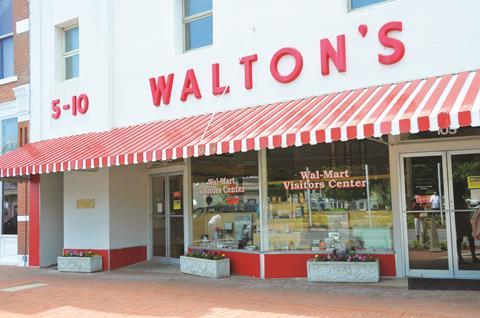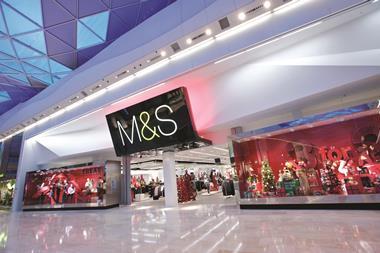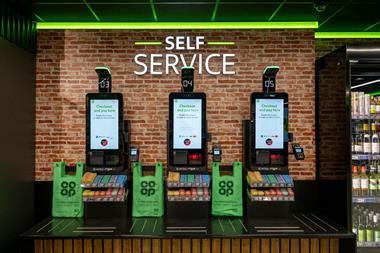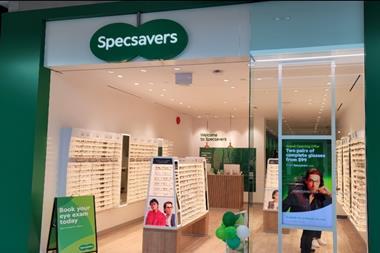Half a century ago today Sam Walton opened his first Walmart store in Rogers, Arkansas. George MacDonald examines how the company went on to change the global retail landscape.

From its origins as a single store in the south of the US, Walmart grew to become the world’s biggest retailer and transformed the industry. Since 1962, Walmart has returned $101bn (£65.5bn) to shareholders through dividends and buybacks and earnings climbed from $30,000 (£19,300) to $15.8bn (£10.1bn). Sales have risen from $250,000 (£160,000) to $443.9bn (£285.3bn).
How did it do it? The stores giant continually broke new ground and established many of the retail principles that today are taken for granted and replicated worldwide.
The foundations of success were deceptively simple and at the heart of the proposition was price. Founder Sam Walton was a pioneer of everyday low prices – EDLP – and that model was taken up by retailers all over the world.

In his autobiography, Made in America, Walton, who died in 1992, said: “Say I bought an item for 80 cents. I found that by pricing it at $1 I could sell three times more of it than by pricing at $1.20. I might make only half the profit per item but because I was selling three times as many, the overall profit was much greater. Simple enough.”
EDLP has been deployed since by many others, for instance by Asda which was subsequently bought by Walmart. It has sometimes fallen from fashion as retailers became concerned that it was deals and bargains that would draw shoppers, but is once again being adopted in continued tough trading conditions.
The focus on low prices was accompanied at Walmart by equally relentless attention to costs – essential for the business model to work. Cost control was one of Walton’s 10 rules for building a business. He said: “You can make a lot of different mistakes and still recover if you run an efficient operation. Or you can be brilliant and still go out of business if you’re too inefficient.”
Walmart became famous for its penny-conscious approach, including managers sharing hotel rooms while travelling on business, and constantly looked for new ways to bring costs down. The mindset still exists today. Last year Walmart set itself the target of cutting operating expenses as a percentage of sales by at least 100 basis points over five years.
One step ahead
Walmart has also become famous for its smart adoption of technology, enabling greater efficiencies and improved communication as the business grew rapidly. By 1988 Walmart controlled the biggest private satellite network in the US, which was used for everything from the transmission of training videos to stores, the monitoring of trucks’ positions so that distribution was made as efficient as possible, and authorisation of credit card transactions, which sped up processing and cut fraud.
Along with the rigorous business disciplines, Walmart developed a unique company culture. Sometimes seen as cultish for practices such as the ‘Walmart cheer’ that starts every day in stores, the Saturday meetings which head office staff must attend and the revivalist-style annual general meeting, the retailer has nevertheless created a strong corporate ethos that has been mirrored across the retail world, from the adoption of the term associates to refer to staff to the introduction of in-store greeters.
Walton instituted the 10-ft rule, the pledge that whenever associates were within that distance of a customer they would “look him in the eye, greet him, and ask if I can help him”. While some find the Walmart way cheesy, nobody would dispute its success.
The retailer showed the way on formats, moving from its discount heritage to develop the Walmart Supercenter and the Sam’s Club membership scheme, and was early to see the opportunity of internationalisation. The first store outside the US was a Sam’s Club that opened in Mexico in 1991, and two years later Walmart International was formed. By 1996, the retailer had formed a joint venture in China.
The overseas push has continued. Walmart’s decision to buy South African retailer Massmart last year has been taken as a sign that a retail scramble for Africa is now under way.
Rocky road
Walmart has, of course, had its share of difficulties over the years. It became a lightning-rod for fears about the power of big retailers, whether wielded over suppliers or blamed for the decline of local town centres.
It also hit problems as it expanded internationally, beating the retreat from Germany in 2006 and this year facing accusations of corruption in Mexico. However, Walmart perhaps showed the way to other retailers that faced similar problems when, in 2005, it put environmental sustainability at the top of its agenda.
As it grew from its roots in Arkansas to become the world’s biggest retailer, Walmart crated awe and fear in equal measure among competitors. But for all its power, Walmart proved not to be invincible.
When Walmart acquired Asda in 1999, many feared that UK retail would be bulldozed by the giant.
That did not happen. While Asda has benefited from Walmart’s ownership and shipped its own good ideas, such as the George clothing line, back into Walmart, it still faces ferocious competition and rivals such as Sainsbury’s and Tesco grew stronger in the interim.
Walmart certainly remains one of the world’s greatest retailers 50 years since its foundation. However, today, fast-growing retailers such as Amazon look like the Walmarts of the future.
Walmart has generally shown that it too can move with the times and the retailer’s chief executive Mike Duke will be determined to keep it in good shape so that 50 years from now it will still be a leading player, though in a different retailing world.


























No comments yet